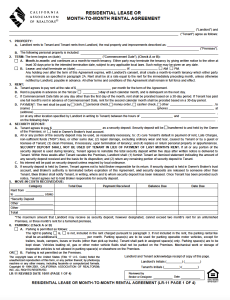
The California lease agreement outlines the arrangement between a landlord and a tenant in regard to occupying a property for a specified time period. Certain stipulations and disclosures are made within the document providing legal protection for the lessor and lessee in the event that one party violates one of the written provisions. Both sides of the transaction must sign off on the contract in order for the document to take effect.
Rental Application – A fillable form provided to prospective tenants to ensure they are a good fit for a particular property. An evaluation can be performed to certify that the income and background information is sufficient for the needs of the lessor.

California Association of Realtors Residential Lease Agreement – The Association of Realtors have produced an alternate version of the form made available to renters and landlords. The paperwork can be completed according to the specifications of the PDF instructions and confirmed with signatures from the lessor and lessee upon agreement.
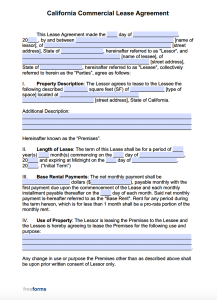
Commercial Lease Agreement – This is specifically designed for the leasing of a property that is going to be used to facilitate a company’s business matters.
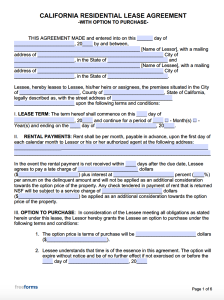
Lease to Own Agreement – Is an option that allows a tenant to rent a property for a fixed period of time with the ability to purchase the real estate if desired.
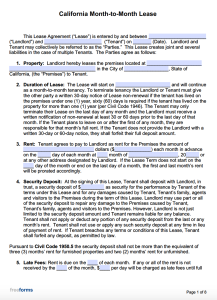
Month-to-Month Lease – A low commitment alternative that enables the lessee to rent the property for a period of one (1) month at a time (it should be mentioned that thirty (30) days’ notice is demanded before terminating the tenancy).
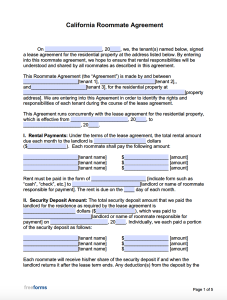
Roommate Agreement – For individuals looking to establish the terms of an arrangement involving the renting of a room/private quarters located within the confines of a residential property.
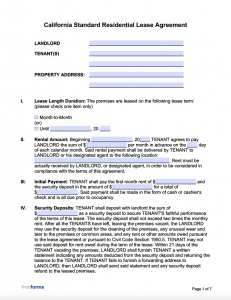
Standard Lease Agreement – Paperwork used to formalize granted rental rights and responsibilities of a property to form a legal bond between a landlord and tenant.
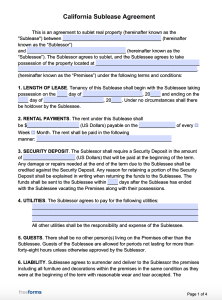
Sublease Agreement – If the primary lease allows it, this can be implemented when a “sublessor” would like to rent property to a “sublessee”.
The HCD (Housing and Community Development) offers a Guide to Residential Tenants’ and Landlords’ Rights and Responsibilities that encompasses all the information that a lessor or lessee would need to know concerning the state’s required rules/regulations for renting a property.
Asbestos (§ 25915 – § 25915.5) – If an owner is aware that asbestos is contained within a property that was constructed before 1979, they must notify all individuals who are part of the building of its presence and location, including new tenants.
Bed Bug Addendum (§ 1954.603) – As of January 1st, 2018, landlords must provide a bed bug addendum to all new & existing tenants. The addendum must include information about the bug, prevention, and how to notify the landlord of a suspected infestation.
Contact Details (§ 1962) – The owner or individual who is authorized to act on the behalf of the owner must supply their name, address, and phone number, as well as the individual responsible for managing the property. Also, they must disclose information regarding where, when, and how the rent payments may be made.
Death (§ 1710.2) – If a death has occurred within the confines of the rental property within the past 3 years, the landlord or agent must convey this knowledge to the new tenant (not including instances where the individual passed away from the AIDS virus).
Demolition (§ 1940.6) – If a property owner has applied for a permit to demolish their building, all prospective tenants must be made aware of the future plans before finalizing the lease agreement.
Flood Hazard (§ 8589.45) – If the rental property is situated in a location where there is a high risk of flooding, the landlord must disclose this knowledge within the lease agreement that is provided to the new tenant (as of July 1st, 2018).
Lead-Based Paint (42 U.S. Code § 4852d) – The EPA & HUD put forth a federal regulation requiring that all rental properties that were constructed prior to 1978 and contain lead paint come equipped with a leasing agreement that discloses the potential risks of coming into contact with the noxious substance.
Megan’s Law (§ 2079.10(a)) – New tenants must be notified (in writing within the content of the lease agreement) that the California Department of Justice operates a website that shares reports concerning registered sex offenders.
Methamphetamine Contamination (§ 25400.45) – Lessors are liable to disclose any information regarding a property that has been exposed to dangerous chemicals used to manufacture the illicit drug methamphetamine (for more info, review the Methamphetamine Contaminated Property Cleanup Act of 2005).
Mold (§ 26147) – If the individual renting/leasing the property knows there is a harmful mold presence contained within the structure, they must notify any new or existing tenants. A disclosure form may be presented if the landlord has no knowledge of mold contamination.
Pest Control (§ 1940.8) – Landlords must supply all new tenants with a notice informing the future occupants of any existing contract between the lessor and a pest control company. The company that maintains the building’s pest control will then notify all parties regarding the application of pesticide/treatment (§ 8538).
Proximity to a Military Base (§ 1940.7) – Owners/Landlords of residential dwellings that are located within 1 mile of a military base containing heavy ordnance are obligated to disclose this fact prior to the fulfillment of a lease agreement.
Smoking Policy (§ 1947.5) – Prior to the tenancy, the landlord must furnish the rental agreement with a full disclosure outlining the rules and regulations for smoking cigarettes (tobacco) on the property, or stipulating that smoking on the premises is prohibited entirely. (The HCD offers a guide on How Landlords Can Prohibit Smoking in Rental Housing.)
Utilities (§ 1940.9) – A lessor must provide information to the lessee regarding what utilities are shared between the communal areas and their unit, and how the cost is split. If the utilities are shared with fellow tenants, the landlord will have to disclose the formulas that demonstrate how the bill is divided.
There is no state-mandated grace period, rent is owed on the date provided within the lease agreement (§ 1947).
According to the late fee section of the HCD’s guide, there is no predetermined fee that can be charged when a tenant is overdue. The landlord may impose a reasonable fee that is congruent with any cost they may have incurred due to the late payment.
A lessee who provides an NSF (non-sufficient funds) check is subject to a fee that covers any costs the lessor may have received while attempting to deposit the payment (as stated in the dishonored check section of the HCD’s guide). The individual who supplied the bad check is responsible to pay the amount of the check as well as a service fee that may not exceed the amount of $25 for the first check, $35 for subsequent checks (§ 1719).
In the state of California, a landlord may only request a maximum of two (2) months rent for an unfurnished property or three (3) months rent for a property containing furniture (§ 1950.5(c)).
In every state, there is a specific time period in which the lessor must return the security deposit to the lessee. In California, the deadline is twenty-one (21) days from the time the lessee moved out and terminated the tenancy (§ 1950.5(g)). An itemized list will need to be provided via first-class mail or personal delivery if there are deductions from the original amount for:
A landlord must give the tenant twenty-four (24) hours of advanced notice (in writing) before entering/accessing the rental property (§ 1954(a)). The notice should include the following: